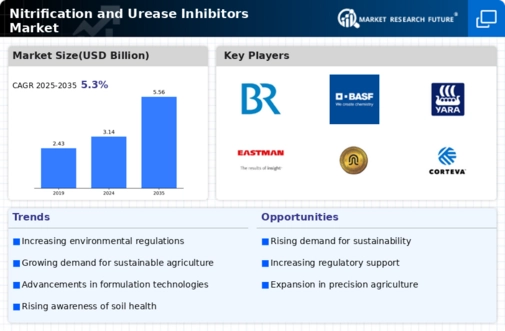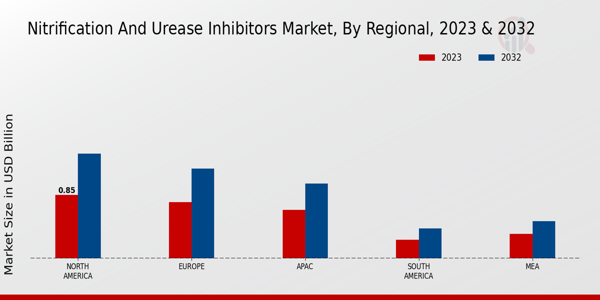Global Market Expansion
The Global Nitrification and Urease Inhibitors Market Industry is witnessing expansion into emerging markets, where agricultural practices are evolving rapidly. Countries in Asia-Pacific and Latin America are increasingly adopting modern agricultural techniques, which include the use of nitrification and urease inhibitors. This expansion is fueled by the need for improved crop productivity and soil management in regions facing challenges such as soil degradation and nutrient depletion. As these markets grow, they present significant opportunities for manufacturers and suppliers, contributing to the overall growth trajectory of the market.
Environmental Regulations
Stringent environmental regulations are shaping the landscape of the Global Nitrification and Urease Inhibitors Market Industry. Governments worldwide are implementing policies aimed at reducing nitrogen runoff and mitigating environmental impacts associated with fertilizer use. These regulations encourage the adoption of nitrification and urease inhibitors, which help minimize nitrogen leaching into water bodies. As a result, the market is poised for growth, with projections indicating a rise to 5.56 USD Billion by 2035. Compliance with these regulations not only supports environmental sustainability but also enhances the market appeal of these inhibitors among farmers and agricultural stakeholders.
Market Growth Projections
The Global Nitrification and Urease Inhibitors Market Industry is projected to experience substantial growth in the coming years. With a market value of 3.14 USD Billion in 2024, it is anticipated to reach 5.56 USD Billion by 2035, reflecting a robust growth trajectory. The compound annual growth rate (CAGR) of 5.33% from 2025 to 2035 indicates a sustained demand for these products as agricultural practices evolve. This growth is driven by various factors, including increasing agricultural demand, stringent environmental regulations, and rising awareness of sustainable practices, positioning the market for a promising future.
Technological Advancements
Technological advancements in the formulation and application of nitrification and urease inhibitors are driving innovation within the Global Nitrification and Urease Inhibitors Market Industry. New formulations that enhance the efficacy and longevity of these products are being developed, allowing for more precise application and improved performance. This innovation not only increases the effectiveness of nitrogen management but also aligns with the growing trend towards precision agriculture. As farmers increasingly adopt technology-driven solutions, the market is expected to grow at a CAGR of 5.33% from 2025 to 2035, indicating a robust future for these inhibitors.
Increasing Agricultural Demand
The Global Nitrification and Urease Inhibitors Market Industry is experiencing a surge in demand driven by the need for enhanced agricultural productivity. As the global population continues to rise, the pressure on agricultural systems to produce more food intensifies. Nitrification and urease inhibitors play a crucial role in optimizing nitrogen use efficiency, thereby reducing fertilizer losses and improving crop yields. In 2024, the market is projected to reach 3.14 USD Billion, reflecting the growing recognition of these inhibitors as essential tools for sustainable agriculture. This trend is likely to continue as farmers seek solutions to meet the increasing food demand.
Rising Awareness of Sustainable Practices
There is a growing awareness among farmers and agricultural stakeholders regarding the importance of sustainable practices, which is positively influencing the Global Nitrification and Urease Inhibitors Market Industry. As environmental concerns gain prominence, farmers are increasingly seeking solutions that enhance soil health and reduce the ecological footprint of their operations. Nitrification and urease inhibitors are recognized for their role in promoting sustainable nitrogen management, thereby supporting the transition towards more eco-friendly agricultural practices. This shift is likely to drive market growth, as stakeholders prioritize products that align with sustainability goals.













